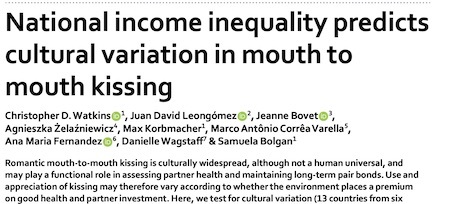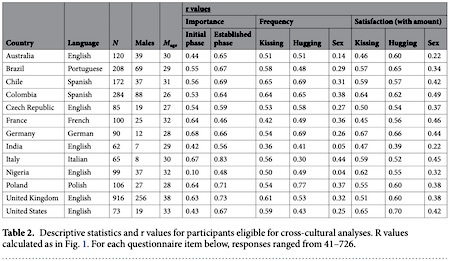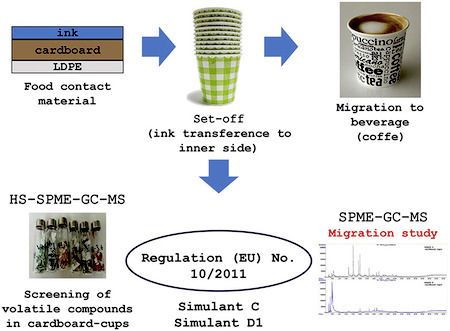Marc Abrahams's Blog, page 147
May 27, 2019
Phase separation of cheese fondue – and what can be done about it [new study]
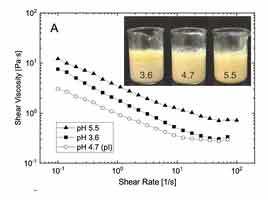 “The irreversible phase separation of fondue is a common issue and has ruined countless dinners.” This state of affairs has been compounded by the fact that : “Many half-truths persist in Swiss kitchens on how to prepare the perfect fondue.” So explain Pascal Bertsch, Laura Savorani, and Peter Fischer of the Institute of Food Nutrition and Health, ETH Zurich, Switzerland, in a new paper for ACS Omega, 2019, 4 (1), pp 1103–1109,
“The irreversible phase separation of fondue is a common issue and has ruined countless dinners.” This state of affairs has been compounded by the fact that : “Many half-truths persist in Swiss kitchens on how to prepare the perfect fondue.” So explain Pascal Bertsch, Laura Savorani, and Peter Fischer of the Institute of Food Nutrition and Health, ETH Zurich, Switzerland, in a new paper for ACS Omega, 2019, 4 (1), pp 1103–1109,
Their research project is intended to sieve out problematic half-truths and replace them with hard science facts. Such as :
“Fondue can be considered a water-continuous system with dispersed fat droplets, caseins, and starch. The caseins remain aggregated after melting and are governed by pH-dependent electrostatic interactions.”
[…]
“The irreversible phase separation of fondue is a common issue and has ruined countless dinners. It may be avoided by sufficient addition of water-binding thickeners, for example, 3 wt % starch relative to the total water content.”
Click here to dip into a full copy of Rheology of Swiss Cheese Fondue

May 25, 2019
The Value of Spit, in the Art World
A proper appreciation of spit might have prevented an art tragedy. The tragedy is reported by VN Express International:
HCMC museum takes a national treasure to the cleaners
A precious lacquer painting suffered 30 percent damage during cleaning process due to cleaner’s lack of knowledge in art.
The painting, Vuon Xuan Trung Nam Bac (Spring Garden of Centre, South and North), is a prominent artwork displayed in the Ho Chi Minh City Fine Arts Museum.
Last year, Luu Minh Phung was tasked by the museum to clean the painting and he took it to the cleaners, seriously damaging its surface by using dishwashing liquid, a polishing powder and sandpaper.
The intent and message of the artwork has been damaged by around 30 percent, said Vi Kien Thanh, head of the Fine Arts, Photography and Exhibition Department of the Ministry of Culture, Sports and Tourism….
Often, Spit is Better
The value of spit was celebrated with the 2018 Ig Nobel Prize for chemistry. The prize was awarded to Paula Romão, Adília Alarcão and the late César Viana, for measuring the degree to which human saliva is a good cleaning agent for dirty surfaces.
They describe their research, in the paper: “Human Saliva as a Cleaning Agent for Dirty Surfaces,” Paula M. S. Romão, Adília M. Alarcão and César A.N. Viana, Studies in Conservation, vol. 35, 1990, pp. 153-155.

May 24, 2019
How phonies and self-promoters came to rule the world
“Our obsession with money and susceptibility to charisma, over-confidence and surface gloss have propelled us into an age where sham, spin, trickery and twaddle have become the new norms,” writes Shelley Gare, in the Sydney Morning Herald:
How phonies and self-promoters came to rule the world
… We can’t say we weren’t warned….
Almost 25 years ago, David Dunning, a psychology professor at Cornell University in upper New York state, became fascinated by a trait he had noticed in some of his students taking tests: “They expressed all sorts of confidence about how they’d done but no, they hadn’t done all that well.”
He wondered about its relevance in the workplace: “I was trying to figure out: do incompetent people really not know how badly they are performing?” On the phone from Ann Arbor, where Dunning now works at the University of Michigan, he marvels as he recalls how he and a graduate student, Justin Kruger, “decided to take a look at the people who were doing really poorly and we tested them on logic, grammar and humour. And what we discovered was that – after the tests and after they had seen the responses of other, more competent students – the people at the bottom wouldn’t revise their self-impression at all.” They continued to over-estimate how well they had done. “After that, even I was convinced the theory was right,” Dunning laughs.
Their 1999 findings are known as the Dunning-Kruger effect. It explains how many incompetent people not only are confident that they are competent but, it also turns out, when they see real competence, their incompetence means they can’t recognise it. Meanwhile, in a true catch-22, competent people, because they know what they don’t know, will underestimate their competence – and often be less confident. Dunning and Kruger’s findings spawned hundreds of articles and features, and a musical rendition, The Incompetence Opera. In 2000, the authors were awarded the Ig Nobel prize, which celebrates research “that makes you laugh, then think”. The election of uber-confident businessman Donald Trump to the White House in 2016 only gave the theory fresh life….
Here’s video of the Dunning Kruger Song, the thrilling finale to The Incompetence Opera. The opera premiered as part of the 2017 Ig Nobel Prize ceremony:

Art is in the AI of the beholder: Making Mona Lisa Move
Art is in the AI of the beholder, so to speak. In a report called “Mona Lisa frown: Machine learning brings old paintings and photos to life,” Techcrunch describes what’s in a new research paper:
…Machine learning researchers have produced a system that can recreate lifelike motion from just a single frame of a person’s face, opening up the possibility of animating not just photos but also paintings. It’s not perfect, but when it works, it is — like much AI work these days — eerie and fascinating…. The more data it has, the better, but it can do it with one image — called single-shot learning — and get away with it. That’s what makes it possible to take a picture of Einstein or Marilyn Monroe, or even the Mona Lisa, and make it move and speak like a real person.
This video shows some of the art in action:

May 23, 2019
The F note, a harmonious accompaniment to the F word
The Bibliolore blog tells some history about the supposed significance of the musical note F:
The F note, one could say, has a musing-and-fraudulent aura that makes it a good musical accompaniment to the F word.
In The voice of the silence (1889), Helena Blavatsky (above) designated the pitch F as the keynote of nature. Blavatsky’s authority was Benjamin Silliman, a Professor of chemistry at Harvard; his source was probably The music of nature (1832) by William Gardiner. Beethoven’s sixth symphony had already established F as the favored “pastoral” key.
Blavatsky’s prestige perpetuated the designation among Theosophists, and it remains a popular New Age concept, though some maintain that the correct note is F sharp. Several musicologists have suggested ingenious rationales for the idea that F is a fundamental keynote.
This according to “Is there a keynote of nature?” by Joscelyn Godwin, an essay included in Esotericism, religion, and nature (East Lansing: Association for the Study of Esotericism, 2009, pp. 53–71)….

The carbon footprints of various sandwiches [study]
There’s a chance (as yet unquantified) that you’re eating a sandwich as you read this. If so, you might pause to consider its carbon footprint – which, it turns out, is likely to be content-dependent. That’s one of the findings of a 2018 study from Dr Namy Espinoza-Orias and Professor Adisa Azapagic of the Sustainable Industrial Systems dept., School of Chemical Engineering and Analytical Sciences, The University of Manchester, UK.
“This study estimated the carbon footprint associated with the production and consumption of sandwiches, prepared commercially and at home. In total, 40 most popular recipes were considered. The carbon footprint of a ready-made sandwich ranges from 739 g CO2 eq. for egg & cress to 1441 g CO2 eq. for the breakfast option. The carbon footprint of the most popular home-made sandwich (ham & cheese) varies from 399-843 g CO2 eq. per serving. The average impact from the home-made option (609 g CO2 eq.) is 2.2 times lower than the impact from the commercial equivalent with the same ingredients (ham, cheese and mayonnaise).”
Details of their paper : Understanding the impact on climate change of convenience food: Carbon footprint of sandwiches can be found online in the journal Sustainable Production and Consumption, Volume 15, July 2018, Pages 1-15.
And which may be digested in full here

May 22, 2019
“National Income Inequality Predicts Cultural Variation in Mouth to Mouth Kissing”
A new study marries, so to speak, economics and kissing. The study is:
“National Income Inequality Predicts Cultural Variation in Mouth to Mouth Kissing,” Christopher D. Watkins, Juan David Leongómez, Jeanne Bovet, Agnieszka Żelaźniewicz, Max Korbmacher, Marco Antônio Corrêa Varella, Ana Maria Fernandez, Danielle Wagstaff, and Samuela Bolgan, Scientific Reports, vol. 9, article no. 6698 2019. (Thanks to Tony Tweedale for bringing this to our attention.) The authors explain:
Romantic mouth-to-mouth kissing is culturally widespread, although not a human universal…
Here, we test for cultural variation (13 countries from six continents) in these behaviours/attitudes according to national health (historical pathogen prevalence) and both absolute (GDP) and relative wealth (GINI)…. When aggregated, the predicted relationship between income inequality and kissing frequency was over five times the size of the null correlations between income inequality and frequency of hugging/cuddling and sex.
Here is some numerical detail:

May 21, 2019
The Secrets Within Prince Shōtoku: The 70 objects inside him
Secrets will be revealed about how the the secrets were revealed about what was secreted inside a seemingly simple statue:
When the sculpture arrived in the United States in 1937, a visiting Japanese conservator discovered that it contained an extraordinary cache of more than 70 dedicatory objects. It has taken over 80 years to begin to unlock the complex secrets of this princely time capsule, thanks to advances in technology and scholarship.
The secrets will be revealed, we are told, in a talk on Tuesday, May 28, at 4:15 pm, at the Harvard Art Museums in Cambridge, Massachusetts. It’s called “Prince Shōtoku: The Secrets Within.”

May 20, 2019
The mystery of cutting things in half [philosophical study]
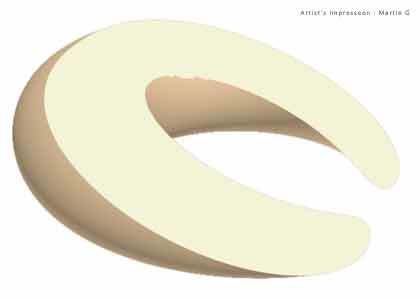 Butchers, bakers and donutmakers probably won’t forsee all that much trouble in cutting something in half. If you’re a philosopher on the other hand . . . Problems arise when trying (to imagine) the process of cutting something exactly in half. Given that most objects could be said to have a centre point of some kind, then, if that object is cut in half, could just one of the two parts ends up with the point? If one half gets the point and the other doesn’t, then the two halves aren’t equal – so the object hasn’t been truly cut in half.
Butchers, bakers and donutmakers probably won’t forsee all that much trouble in cutting something in half. If you’re a philosopher on the other hand . . . Problems arise when trying (to imagine) the process of cutting something exactly in half. Given that most objects could be said to have a centre point of some kind, then, if that object is cut in half, could just one of the two parts ends up with the point? If one half gets the point and the other doesn’t, then the two halves aren’t equal – so the object hasn’t been truly cut in half.
Dr Aaron J Cotnoir. who is a senior lecturer in the Department of Philosophy at the University of St Andrews, Scotland and part of the Arché Philosophical Research Centre, examines such things in his essay ‘How to make donuts and cut things in half ‘ which can be read in its entirety here.
Pointing out – en passant – that :
“As usual, there are no perfect solutions in philosophy, but there are many good ones. And not all good solutions are equally good.”
BONUS: Dr Cotnoir has also investigated whether a God could create a stone so heavy that he/she/it would be unable to lift it and the question of How Many Angels Can be in the Same Place at the Same Time
The illustration shows (one way) to cut a ring-donut (approximately) in half – creating only one boundary with no holes rather than two.
Research research by Martin Gardiner

May 19, 2019
Migrant Warning: Crossing the Coffee-Cup Barrier
When you get a cup of coffee from a vending machine, are you getting a soupćon of ink in your drink? This study looks into that question:
“Determination the Set-Off Migration of Ink in Cardboard-Cups Used in Coffee Vending Machines,” Esther Asensio, Teresa Peiro, and Cristina Nerín, Food and Chemical Toxicology, epub 2019. The authors, at the University of Zaragoza, Spain, explain:
Food and beverages may interact strongly with the materials that they touch and this is specially important in vending machines, where often the contact is at high temperature. These interactions may result in migration of substances from the food contact materials to the beverages, affecting both the odour, quality of food as well as the health of consumers….
The aim of this study was the determination of the migration of compounds coming from different types of cardboard-cups used in coffee vending machines. The volatile compounds present in cardboard-cups were studied and specific migration studies were carried out by solid phase microextraction with headspace coupled to gas chromatography (HS-SPME-GC-MS). The migration of compounds from the cardboard-cups manufacturing material, plastic coating (LDPE) and printing inks were identified and quantified….
it is important to highlight the presence of compounds from both the material of the cardboard-cups (wood pulp) and the plastic coating (LDPE). Several compounds classified as Class II and Class III according to the Cramer rules, stand out the importance of the study and the required control of them, while their analysis suggests that this food contact material is unlikely to contribute significantly to dietary Cramer-threshold exceedance….
Some of the compounds found are not authorized for building food packaging materials. Even though they are coming from printing inks, the contact layer in the cups is LDPE, what makes this structure as a multilayer and then, included in the regulation 10/2011/EU. It is well known that diffusion of low polar organic molecules in LDPE is very fast and consequently the sorpted compounds in direct contact with LDPE can be easily transferred to the food.

Marc Abrahams's Blog
- Marc Abrahams's profile
- 14 followers






